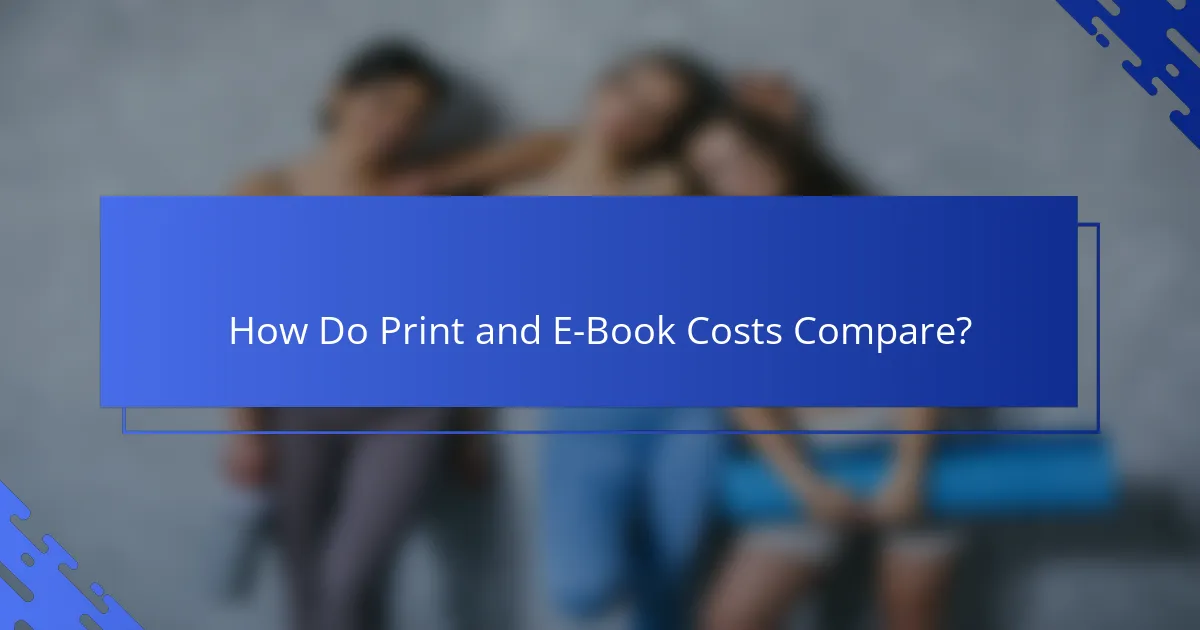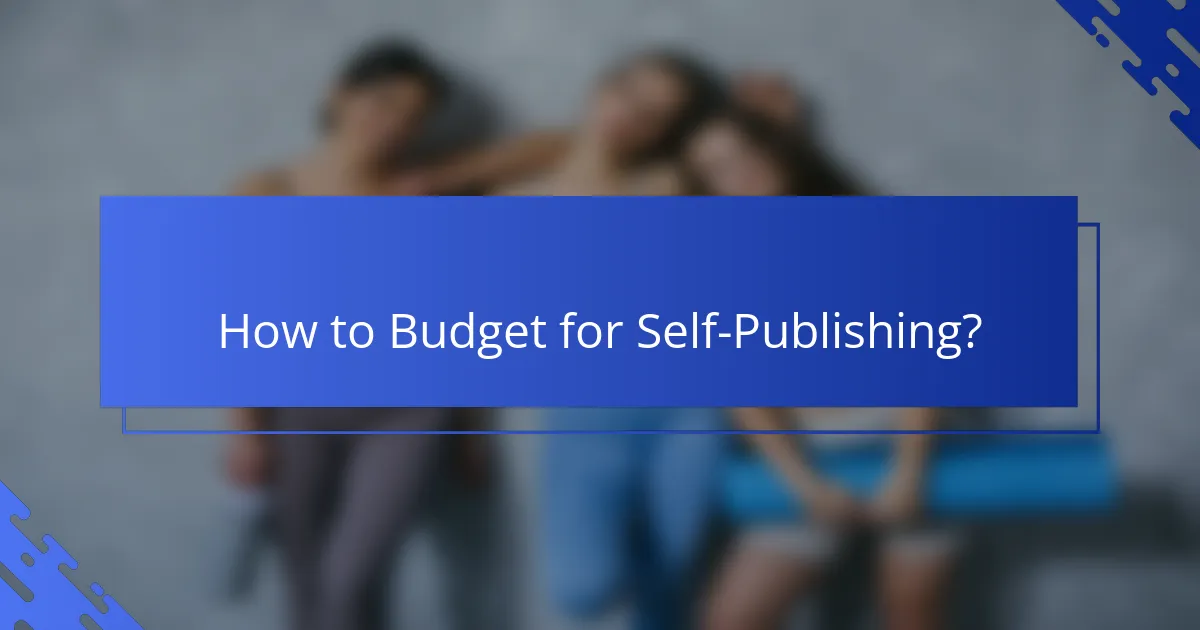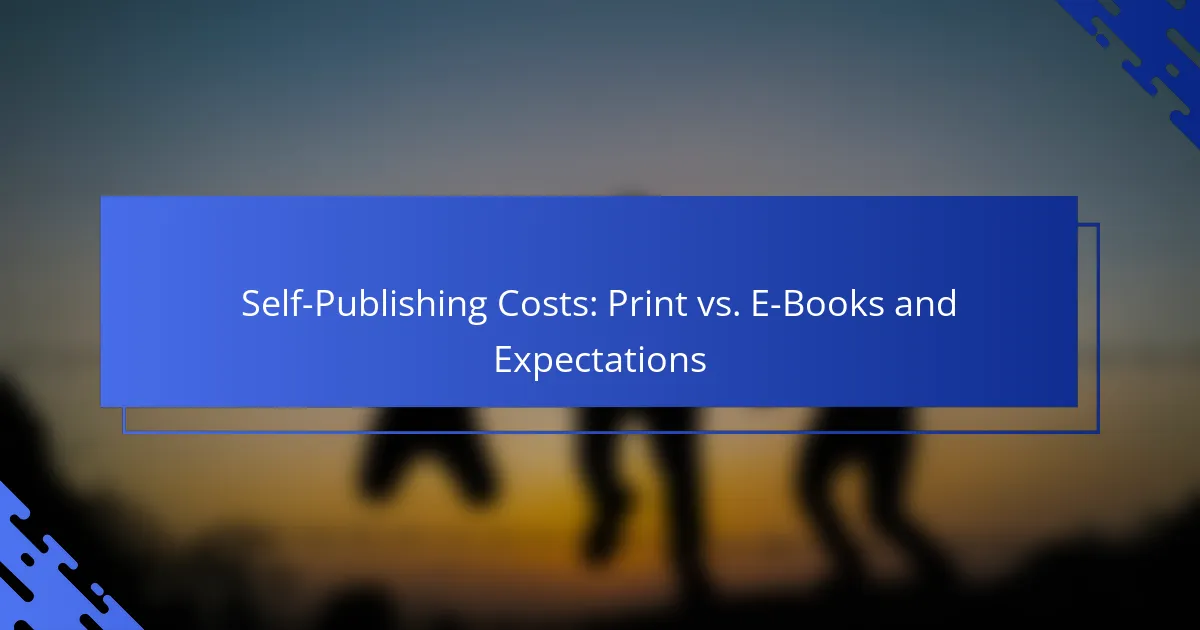Self-publishing offers authors the opportunity to bring their work to market, but understanding the associated costs is essential for success. From print book production to e-book formatting, each format presents unique financial considerations that can affect your overall budget and potential profits. By being aware of both upfront and hidden costs, authors can make informed decisions and strategically plan their publishing journey.

What Are the Main Costs of Self-Publishing?
The main costs of self-publishing include expenses related to print book production, e-book formatting, marketing and distribution, editing and design services, and platform fees. Understanding these costs is crucial for authors to budget effectively and maximize their potential returns.
Print book production costs
Print book production costs encompass several elements, including printing, binding, and shipping. Authors can expect to spend anywhere from a few hundred to several thousand dollars, depending on factors like print run size and quality of materials used.
When calculating these costs, consider options such as print-on-demand services, which can reduce upfront expenses by allowing authors to print copies as needed. However, bulk printing often lowers the per-unit cost, so weigh the benefits of each approach based on your sales strategy.
E-book formatting expenses
E-book formatting expenses involve converting your manuscript into a digital format suitable for various e-readers. This process can cost between $50 and $300, depending on the complexity of the formatting and whether you hire a professional or use DIY tools.
Investing in quality formatting is essential, as poorly formatted e-books can lead to negative reader experiences and lower sales. Consider using popular software or hiring freelancers who specialize in e-book formatting to ensure a polished final product.
Marketing and distribution fees
Marketing and distribution fees are crucial for reaching your target audience and can vary widely. Authors should budget for promotional activities, which may include social media advertising, book launch events, and email marketing campaigns, often totaling several hundred to thousands of dollars.
Distribution fees can also apply when using platforms like Amazon or IngramSpark, which may take a percentage of sales or charge upfront fees. Research different distribution channels to find the most cost-effective options for your book’s genre and target market.
Editing and design services
Editing and design services are vital for producing a professional-quality book. Editing costs can range from a few hundred to several thousand dollars, depending on the level of editing required (developmental, copyediting, or proofreading).
Cover design is equally important, with professional designs typically costing between $200 and $1,500. Investing in these services can significantly enhance your book’s appeal and increase its chances of success in a competitive market.
Self-publishing platforms fees
Self-publishing platforms often charge fees for their services, which can include setup fees, distribution costs, and royalties taken from sales. For example, platforms like Amazon Kindle Direct Publishing (KDP) do not charge upfront fees but take a percentage of royalties, typically around 30-65% depending on the pricing model.
Evaluate different platforms based on their fee structures and services offered. Some may provide additional marketing tools or distribution networks that can justify higher fees, so choose one that aligns with your publishing goals and budget.

How Do Print and E-Book Costs Compare?
Print and e-book costs differ significantly in terms of production and distribution. While print books typically incur higher upfront costs due to materials and printing, e-books have lower production expenses but may involve ongoing costs related to platform fees and marketing.
Cost breakdown for print books
Print book costs include expenses for materials, printing, and distribution. Authors can expect to pay anywhere from a few hundred to several thousand dollars depending on the print run size, quality of materials, and whether they choose print-on-demand services.
Key costs to consider are cover design, interior formatting, and shipping. For example, a small print run of 100 copies might cost around $1,000, while larger runs can reduce the per-unit cost significantly.
Cost breakdown for e-books
E-book costs are generally lower, focusing mainly on formatting and distribution fees. Authors may spend a few hundred dollars on professional formatting and cover design, but there are no printing costs involved.
Distribution platforms often take a percentage of sales, typically ranging from 30% to 50%. This means that while initial costs are lower, authors should account for these ongoing fees when pricing their e-books.
Long-term financial implications
Print books can generate higher upfront costs but may lead to greater long-term profits if marketed effectively. Authors can benefit from physical sales at events or bookstores, which can enhance visibility and sales potential.
E-books, on the other hand, often have lower barriers to entry and can be sold globally through various platforms. However, the ongoing fees can add up, impacting overall profitability. Authors should weigh the benefits of each format based on their target audience and sales strategy.

What Are the Hidden Costs of Self-Publishing?
Hidden costs in self-publishing can significantly impact your budget and profits. Beyond initial expenses like editing and design, authors must consider ongoing fees and unexpected expenses that can arise throughout the publishing process.
Royalties and commission structures
Understanding royalties and commission structures is crucial for self-published authors. Typically, platforms like Amazon Kindle Direct Publishing (KDP) offer royalties ranging from 35% to 70% depending on the pricing and distribution choices you make.
When setting your book price, consider how the commission structure affects your earnings. For example, pricing your e-book below a certain threshold may reduce your royalty percentage, impacting your overall revenue.
ISBN and copyright registration fees
Obtaining an ISBN (International Standard Book Number) is essential for selling your book through retailers. In the U.S., a single ISBN costs around $125, while purchasing in bulk can lower the cost per unit. Some self-publishing platforms provide free ISBNs, but these may limit your control over copyright.
Copyright registration, while not mandatory, offers legal protection for your work. In the U.S., this typically costs around $45 to $65 and can be done online. Weigh the benefits of registration against the costs to determine what suits your needs.
Unexpected marketing expenses
Marketing your self-published book often incurs unforeseen costs that can add up quickly. While social media and word-of-mouth can be effective, consider investing in paid advertising, book reviews, or promotional services, which can range from a few dollars to several hundred.
To manage these expenses, set a marketing budget early on and explore cost-effective strategies like building an author website or engaging with readers through newsletters. Avoid overspending on services that do not yield a clear return on investment.

What Factors Influence Self-Publishing Costs?
Several key factors significantly impact the costs associated with self-publishing, including the genre of the book, its length and complexity, and the quality of services selected. Understanding these elements can help authors budget effectively and make informed decisions throughout the publishing process.
Genre and target audience
The genre of a book plays a crucial role in determining self-publishing costs. Different genres may require varying levels of editing, design, and marketing, which can affect overall expenses. For instance, a niche genre may have fewer specialized editors available, potentially increasing costs.
Additionally, understanding the target audience can influence marketing strategies and promotional expenses. A well-defined audience can lead to more effective marketing, potentially reducing costs in that area.
Book length and complexity
Book length directly correlates with publishing costs, as longer works typically require more extensive editing, formatting, and design. Authors should expect to pay more for longer manuscripts, with costs often increasing in tiers based on word count.
Complexity also matters; books that require intricate formatting, such as those with images or specialized layouts, can incur higher costs. Authors should assess their manuscript’s needs and budget accordingly.
Quality of services chosen
The quality of services selected for self-publishing can vary widely, impacting overall costs. Hiring professional editors, designers, and marketers can lead to higher upfront expenses, but may improve the book’s marketability and sales potential.
Authors should weigh the benefits of premium services against their budget. Investing in high-quality editing and cover design can significantly enhance a book’s appeal, while opting for lower-cost services may save money but could compromise quality.

How to Budget for Self-Publishing?
Budgeting for self-publishing involves understanding the various costs associated with both print and e-books. A well-structured budget helps authors allocate funds effectively and avoid unexpected expenses throughout the publishing process.
Creating a detailed budget plan
Start by listing all potential expenses related to self-publishing. This includes costs for editing, cover design, formatting, marketing, and distribution. Use a spreadsheet to organize these items, estimating costs based on research or quotes from service providers.
Consider setting aside a contingency fund, typically around 10-20% of your total budget, to cover unforeseen expenses. This will help ensure that you can manage any surprises without derailing your project.
Identifying essential vs. optional costs
Essential costs are those necessary for producing a quality book, such as professional editing and cover design. These expenses directly impact the book’s marketability and reader experience, so prioritize them in your budget.
Optional costs may include advanced marketing strategies, additional formatting for different platforms, or premium printing options. While these can enhance your book’s success, assess their necessity based on your overall budget and goals to avoid overspending.
